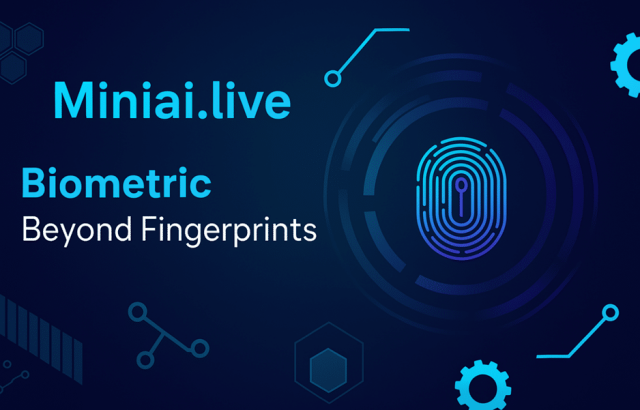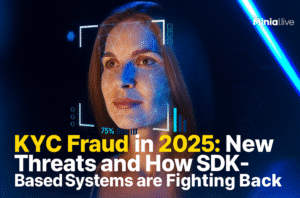There’s a funny thing about fraud is that it never really sleeps. It just changes outfits. One week it’s a fake passport printed on glossy paper, the next it’s an AI-generated “person” who looks more convincing than half the selfies you see online.
Take 2025, for example. A small fintech launches in Asia, everyone’s buzzing, and sign-ups are climbing fast. Then bam. Fake accounts start slipping through, not created by people, but by bots armed with synthetic IDs. Money drains, regulators breathe down their necks, and trust? Gone in seconds.
That’s not some sci-fi tale. It’s happening right now. KYC (Know Your Customer) fraud has leveled up, powered by generative AI, deepfakes, and high-tech identity theft. The ancient barriers no longer suffice.
Here’s what we’re about to unpack:
• Why KYC theft is more dangerous than ever in 2025 and what it looks like.
• The sneaky new tricks fraudsters are pulling.
• How SDK-based systems are stepping up with real-time liveness checks on-device processing, and other clever tools.
• Practical strategies so your business doesn’t end up the next cautionary headline.
Let’s dig in.
What Is KYC Fraud?
KYC fraud happens when someone manages to wiggle past identity checks using stolen, fake, or even AI-generated data. Back in the day, it meant dodgy photocopies or forged documents. Today? We’re talking about face-swapping deepfakes and entire fraud rings running at an industrial scale.
Why should you care? Well the costs are brutal:
• Money gone. Chargebacks stolen funds and fines stack up quickly.
• Reputation wrecked. Consumers do not spare websites that cannot safeguard them.
• Regulators circling. Compliance rules are stricter than ever, and slip-ups don’t get sympathy.
KYC is no longer just a regulatory chore; it’s a survival.
The New Threats in 2025
1. AI-Generated Identities (Synthetic ID Fraud)
Fraudsters now cook up identities out of thin air using generative AI. Photos? Check. Fake social history? Check. Digital “footprints”? Oh yes. These profiles stroll past old verification gates with ease.
Case in point: Several European banks reported loan applications tied to AI-made “people.” None of them existed, but the paperwork fooled basic checks.

2. Deepfake Videos and Face Swaps
Deepfakes aren’t just for memes anymore. They’re fraud weapons. Imagine a customer service agent chatting with what looks like a real user on video, only it’s a perfectly animated fake face.
One scary example: In 2024, employees of a multinational were wired millions after a deepfake version of their CEO asked them to.
3. Stolen and Recycled Biometrics
Here’s the nightmare: someone steals your biometrics. A fingerprint, a face scan, something you can’t exactly “change” like a password. Old systems that stored this data in weak ways are basically treasure chests for fraudsters.
Once it’s stolen, it’s gone.
4. Automated Bot Attacks
Bots are always ready to work. Bots that are driven by AI can constantly try to sign up for things thousands of times in hours, trying different combinations until one works.
That’s like inviting a whole stadium of pickpockets into your shop and hoping none of them gets away with anything.
5. Cross-Border Fraud Rings
Fraud is global now. Networks trade stolen IDs and AI tools on dark web markets, hitting banks, healthcare systems, and even e-commerce platforms in waves.
Think of it as a “fraud supply chain.”
Why Old Systems Are Failing
KYC tools from the past weren’t made for this world. Most rely on slow document uploads, clunky manual checks, or single-step ID scans.
The problems?
• Too slow. Customers bail when the process drags.
• Too weak. Static checks crumble against deepfakes.
• Too centralized. Cloud-only systems are risky and often laggy.
If fraudsters are sprinting, old systems are crawling.
Enter SDK-Based Systems: A Game-Changer
So, what’s turning the tide? SDK (Software Development Kit)-based verification systems. These connect directly to business or mobile apps which speed up KYC and make it better and harder to cheat.
Here’s why they matter:
1. Real-Time Liveness Detection
Do not use the old “blink for the camera” trick anymore. To check if a face is real, modern SDKs look at its depth, texture, small moves, and even light reflections.
Why it matters: Deepfakes can mimic a lot of things, but not the subtle, natural quirks of a live human face.
2. On-Device Processing for Privacy
Instead of shipping sensitive biometrics to the cloud many SDKs process data right on the device.
• Faster results. No waiting for server round-trips.
• More trust. Users know their data isn’t bouncing around online.
3. Multi-Layered Verification
How do you do it? Putting together a number of checks:
• Face recognition
• Document scans
• OCR (reading text on IDs)
• License plate or ID number matching
Fraudsters may slip past one, but getting through all of them? Good luck.
4. Seamless User Experience
No one likes clunky sign-up flows. It’s easy for SDKs to work with apps which speeds up the process and makes it more mobile-friendly. The customers are happy, but the scammers are not.
5. Continuous Updates Against New Threats
Fraud changes every day. When you update an SDK, it learns how to spot the newest fake tricks before they get widely used.
Real-World Example: A Fintech in Southeast Asia
At the beginning of 2024, fake ID theft was destroying a digital bank in Southeast Asia. In three months fake account starts dropped by 87% after the company switched to an SDK with passive liveness detection. Bonus: Customer onboarding sped up by 40%.
That’s what happens when security and convenience finally work together.
The Role of Regulation in 2025
Governments are no longer playing around. New rules now demand:
• Real-time verification: No more delays.
• Privacy-first design: Protect user data or face penalties.
• Proof of reliability: Regulators would like firms to demonstrate that they have systems capable of dealing with fraud.
For many businesses this means SDK-based verification isn’t a “nice-to-have.” It’s a must.
How Businesses Can Prepare
Alright, so how do you get ready for this new wave of fraud?
• Adopt SDK-Based Verification: Go for tools with liveness checks on-device processing and multiple verification layers.
• Train Your People: Tech assists and your teams require consciousness as well as compliance with customer care.
• Track Fraud Trends: Be on watch because deepfakes and fake IDs are evolving.
• Protect Experience: Make sure users are safe and their trip is easy.
• Choose Wisely: Partner with experts who know the field and have proven results.
Beyond the Buzzwords: Why 2025 Fraud Feels Different
In the year 2025, fraud is not only sneaky, it’s also very smart. No longer are we talking about someone making a fake signature or photocopying an ID. Nope. The new wave of fraudsters is renting cloud servers, training machine learning models, and spinning up “people” who don’t even exist. Entire faces, voices, and documents fabricated out of thin air. The scariest part? They look so real, they could call your grandma and she’d swear it was you.
And this isn’t just some cyberpunk horror story. Founders of fresh fintech apps know it all too well. They roll out their platforms, celebrate a spike in new users, and then bam. It turned out that half of those sign-ups were just fake ghosts made with stolen data and AI tricks. The money is gone, officials are circling, and the trust they worked so hard to build is gone. Shaken.
Why Fraudsters Love Old Systems
Here’s the truth that legacy KYC tools are easy prey. They’re like those old suitcase locks; you think they’re protecting something, but anyone with a pen can pop them open.
Take the usual routine: upload an ID photo, maybe snap a quick selfie. Sounds fine on paper. But in practice?
• Too slow: Who wants to wait hours just to prove they’re real?
• Too clunky: If the upload fails once, customers walk.
• Too predictable: And when criminals can guess the system’s moves, they’ll always find a way around.
In 2025, predictability is practically an open invitation. And fraudsters RSVP every time.
SDKs: Fighting Fraud Without Killing the Vibe
This is where SDK-based systems flip the script. They’re like guard dogs that don’t just bark at intruders they sniff out the fakes before they even get near the door. Instead of sending everything off to some distant server SDKs run checks right there on the user’s phone. Real-time liveness detection, micro-movement analysis, and texture scanning all happen instantly.
It’s not just “blink for me” anymore. SDKs can tell if someone’s really there or just a high-quality video loop. It’s like having a bouncer who not only checks your ID but also knows if you’re breathing. No CGI clones’s getting past that.
And the smooth part? Customers barely notice. A tilt of the head, a quick scan, done. Security that works in the background without killing the vibe.
Stories from the Field
One of my favorite examples? A digital wallet service in Africa was drowning in fake sign-ups. Bots were creating thousands of accounts weekly, draining resources and creating chaos. The change was huge when they added an SDK with tiered checks face recognition document scanning and passive liveness. Over 80% less fraud occurred. It was also interesting that real users started signing up more because they thought the process was safer and more reliable.
That’s the sweet spot is when tighter security doesn’t feel like barbed wire but more like a gentle tap on the shoulder saying, “Yep, you’re good to go.”
What This Means for Businesses
So, what’s the move? How do you stay safe in a world where AI is fighting on both sides? The answer’s simpler than it seems: meet AI with AI.
Businesses that stick to outdated systems are leaving the front door wide open. Those who switch to SDK-based KYC? They’re not only dodging fraud losses but also proving to regulators that they take compliance seriously. More importantly, they’re sending a clear message to customers is your identity is safe here.
Fraud in 2025 is wild, no doubt about it. But with the right systems in play, it doesn’t get to decide the story. You do.
Conclusion
KYC fraud in 2025 isn’t about sloppy fakes anymore. It’s AI-powered, fast, and global. Companies that keep using old tools are falling behind and having to pay for it. SDK-based systems are rewriting the playbook. Real-time liveness checks, on-device privacy, layered defenses, they’re what keep companies ahead of fraudsters without slowing down customers.
At MiniAiLive, we believe security shouldn’t be a roadblock. It should be a good thing. Our SDK solutions are built to deal with today’s issues as well as tomorrow’s surprises. Companies get the tools they need to fight scams, follow the rules and earn trust. Are you ready to stay alert? Let’s work together to make the internet better.
FAQs
1. What is KYC fraud?
Criminals commit KYC fraud when they use stolen, fake, or AI-generated names to get around verification checks. In 2025 this includes deepfakes, fake IDs and strikes by bots that are run automatically.
2. Why are SDK-based systems better than legacy KYC tools?
SDKs let you do checks in real time on the device with advanced liveness recognition. Compared to standard cloud-only systems, they are faster, safer and harder for fraudsters to get around.
3. How do SDKs protect customer privacy?
A lot of SDKs handle private personal data right on the user’s device, so it’s less likely to be stolen while being sent to or stored on central servers.
4. Are SDK-based solutions compliant with regulations?
Yes. With privacy-first features that work with frameworks like GDPR most SDK-based verification systems are made to meet global KYC/AML rules.
5. What industries benefit most from SDK-based KYC?
Health care, e-commerce, banking and fintech are the areas that win the most because they deal with private data and have a high risk of fraud.















